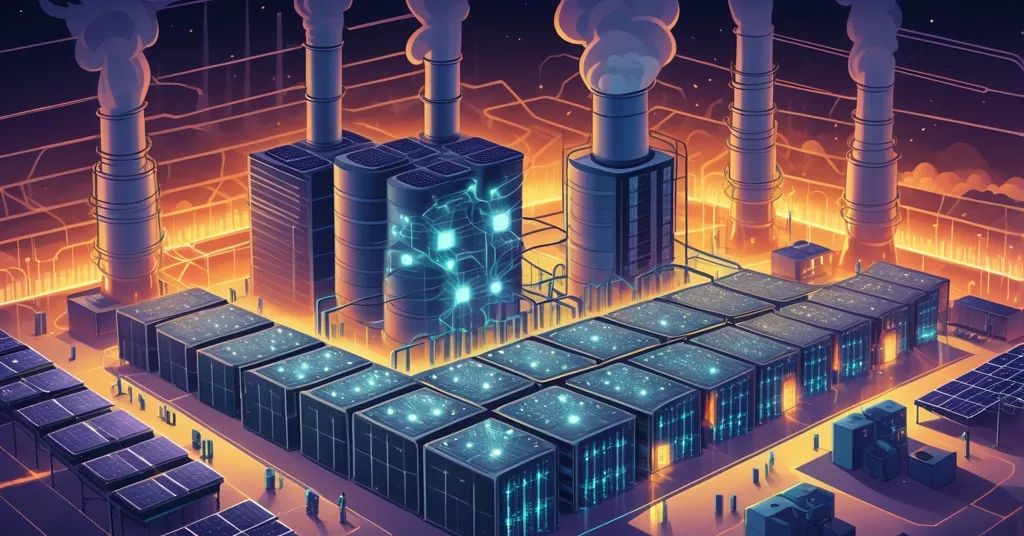AI Energy Crisis Mirrors Bitcoin’s Power Woes as Tech Giants Struggle with Climate Goals

AI Boom Sparks Energy Crisis for Tech Giants, Echoing Bitcoin’s Power Struggles
Big tech is ramming headfirst into an energy wall as the AI boom explodes, and the fallout is eerily familiar to anyone who’s followed Bitcoin’s power-hungry saga. Companies like Microsoft, Amazon, Google, and Meta are scrambling to fuel sprawling data centers, but their skyrocketing energy needs are torching their shiny net-zero climate pledges. Let’s unpack this mess and see what it means for decentralized tech.
- AI Power Hunger: Data centers for AI are set to demand an extra 362 gigawatts globally by 2035.
- Climate Backslide: Carbon emissions for tech giants have spiked—Meta up 64%, Google 51%—despite net-zero goals.
- Crypto Parallel: AI’s energy crisis mirrors Bitcoin mining’s long-standing environmental battles.
The AI Energy Beast Unleashed
The AI revolution is a power guzzler of epic proportions. Training massive models like those behind chatbots or image generators requires supercomputers solving millions of complex calculations non-stop. Think of it as running a digital marathon with no finish line, burning electricity like a Hummer burns gas. The global data center market, already worth $386.71 billion in 2025, is projected to hit nearly $1 trillion by 2034, growing at 11.24% annually. The International Energy Agency (IEA) warns that by 2030, data centers will drive half the increase in U.S. power demand. That’s 362 gigawatts of additional juice needed worldwide by 2035—enough to power roughly 300 million U.S. households for a year based on average consumption.
Tech titans are feeling the heat. Microsoft, Amazon, Google, and Meta have seen their carbon emissions surge—Meta’s up a whopping 64%, Google’s at 51%, Amazon’s at 33%, and Microsoft’s at 23%. Microsoft didn’t shy away from naming the culprit: AI and cloud expansion. These numbers are a brutal slap to their promises of net-zero emissions by 2040, or even sooner for some. As Brian Janous, Microsoft’s former VP of Energy until August 2023, bluntly stated:
“On one hand, tech firms are attempting to obtain every electron they can to fund their trillion-dollar bet on AI. On the other hand, the tech firms are attempting to adhere to the objective of reaching net-zero carbon emissions by 2040 or before.”
Janous also pointed out the obvious: “The current drive to build AI infrastructure is straining the major tech companies’ climate commitments, many of which were made before the development of AI.” Back when these pledges were inked, AI’s insane energy appetite wasn’t on the radar. Now, it’s a runaway train, and the tracks are made of carbon. For a deeper look into how this AI-driven power scramble is challenging tech giants’ green promises, the parallels to other tech sectors are striking.
Green Pledges or Greenwashing?
Before we write off big tech as climate villains, let’s give credit where it’s due—they’re not entirely asleep at the wheel. Amazon, Google, and Microsoft snapped up 40% of global renewable energy purchases in the first half of 2025, totaling 9.6 gigawatts. Google signed a 15-year Power Purchase Agreement (PPA) with TotalEnergies for 1.5 terawatt-hours of renewable electricity from a solar farm in Ohio to power its data centers. For the uninitiated, a PPA is a long-term deal where a company buys electricity straight from a renewable source—think solar or wind farms—securing clean power while funding green projects. Meanwhile, Longroad Energy is building a 400 MWdc solar project called “1000 Mile” in Texas, aimed squarely at data center demands.
But here’s the rub: even with these efforts, the gap between need and supply is a chasm. Renewable projects take years to build, while AI’s power demands grow by the day. Many tech firms are stuck in an “all-of-the-above” mode, grabbing whatever energy they can—often fossil fuels—to keep servers humming. So, net-zero by 2040? Sounds more like net-zero excuses when your carbon footprint balloons faster than a Bitcoin miner’s electric bill.
Political Power Plays Muddy the Waters
The plot thickens with politics entering the fray. In the U.S., President Trump’s administration has slashed federal funding for renewable energy, rolling back tax incentives and grants that once fueled green projects. Instead, there’s a push for fossil fuel generators—including coal—to support AI infrastructure. This puts tech giants in a tight spot. They can’t risk pissing off a political heavyweight, but leaning on dirty energy guts their sustainability cred. It’s a high-stakes game of pragmatism versus PR, and smaller players—like blockchain startups with shallower pockets—could get squeezed even harder by these policy shifts.
This isn’t just a tech giant problem; it’s a systemic one. If federal support for renewables keeps tanking, expect slower progress on clean energy grids. That’s bad news for any energy-intensive tech, centralized or decentralized. Bitcoin miners, already under scrutiny for power use, might face tighter regulations or higher costs if fossil fuels remain the default backup.
Bitcoin’s Energy Ghost Haunts AI
Speaking of Bitcoin, let’s not pretend this energy crisis is new territory for us crypto folks. Bitcoin mining, with its proof-of-work (PoW) consensus, has been slammed for years over its power consumption—estimated at 100-150 terawatt-hours annually, rivaling some mid-sized countries. The parallels with AI data centers are uncanny: both are computationally brutal, both spark environmental outrage, and both are hunting for sustainable fixes. China’s 2021 mining ban over energy concerns showed how fast regulators can clamp down. Could AI data centers face a similar reckoning?
Yet, there’s a decentralized twist. Unlike big tech’s centralized server farms, Bitcoin’s network spreads its energy sin across thousands of independent miners worldwide. Some argue this makes it less of a single-point failure, though it doesn’t dodge the carbon bullet. On the flip side, Ethereum’s switch to Proof-of-Stake (PoS) slashed its energy use by over 99%, proving altcoins can pivot when pushed. Could AI’s energy scramble yield renewable breakthroughs for Bitcoin mining? If tech giants fund massive solar or wind farms, miners might tap into that infrastructure. Hell, maybe we’ll see hybrid grids powering both AI and crypto—call it a begrudging truce in the energy wars.
Devil’s Advocate: Are We Asking Too Much?
Let’s flip the script. Why are we holding tech giants to some saintly climate standard while they’re fighting tooth and nail for AI supremacy? Their job isn’t to save the planet—it’s to innovate and rake in profits. Expecting Microsoft or Meta to lead the green charge when the global energy grid still runs on coal and oil is borderline delusional. Here’s a hot take: maybe AI’s insane power demands will force a reckoning. Could this crisis accelerate grid modernization or renewable adoption faster than any corporate pledge? Think of it as effective accelerationism with an eco edge—push the system to its breaking point, and innovation has to follow. Bitcoin maximalists might even cheer: if centralized tech stumbles, decentralized systems could steal the spotlight.
Powering the Future: Lessons for Crypto
Looking ahead, this energy saga is a wake-up call for all tech, including blockchain. If big tech cracks the code on sustainable power—think nuclear-powered data centers or microgrids—crypto could ride that wave. Imagine miner rigs hooked to off-grid solar farms, dodging both carbon critics and regulatory hawks. But if tech giants double down on fossil fuels, expect the backlash to hit Bitcoin harder than ever. Decentralization and freedom mean jack if your tech can’t run without choking the planet.
Another angle: AI’s push might spark microgrid adoption, small-scale energy networks that operate independently. That’s a dream for decentralized tech, aligning perfectly with crypto’s ethos of cutting out middlemen. But we’re nowhere near there yet. The race for power—literal and figurative—is shaping up to be the defining fight of this digital era. For crypto OGs and newcomers alike, the question is clear: can we build a future where innovation doesn’t burn the house down?
Key Questions and Takeaways
- How is the AI boom impacting tech giants’ climate goals?
The AI surge is wrecking their net-zero pledges, with carbon emissions soaring—Meta up 64%, Google 51%—as data centers demand unprecedented power. - What are tech companies doing to manage energy needs sustainably?
They’re buying renewables in bulk, like Google’s 1.5 TWh solar deal with TotalEnergies, accounting for 40% of global clean energy purchases in early 2025. - How does AI’s energy crisis tie to Bitcoin and blockchain?
It echoes Bitcoin mining’s power debates (100-150 TWh yearly), highlighting the need for sustainable solutions that could benefit both AI and crypto infrastructure. - What role do political shifts play in this energy mess?
U.S. cuts to renewable funding under Trump, favoring fossil fuels, complicate green efforts for tech giants and blockchain projects alike. - Could AI’s energy demands drive innovation for crypto?
Potentially—renewable breakthroughs for data centers might spill over to mining, while microgrids could align with decentralization’s freedom ethos. - Should we expect tech giants to prioritize climate over profit?
Realistically, no—their focus is innovation, but their energy crisis might accidentally accelerate grid upgrades, benefiting all tech, including blockchain.



